Introduced by the FEI in 2014, the Medium Tour — which includes the Intermediate A and Intermediate B tests — is intended as a bridging level between Small Tour and Big Tour. Although designed to ease horses into Grand Prix, as Roger Fitzhardinge explains, they are in no way easy tests!
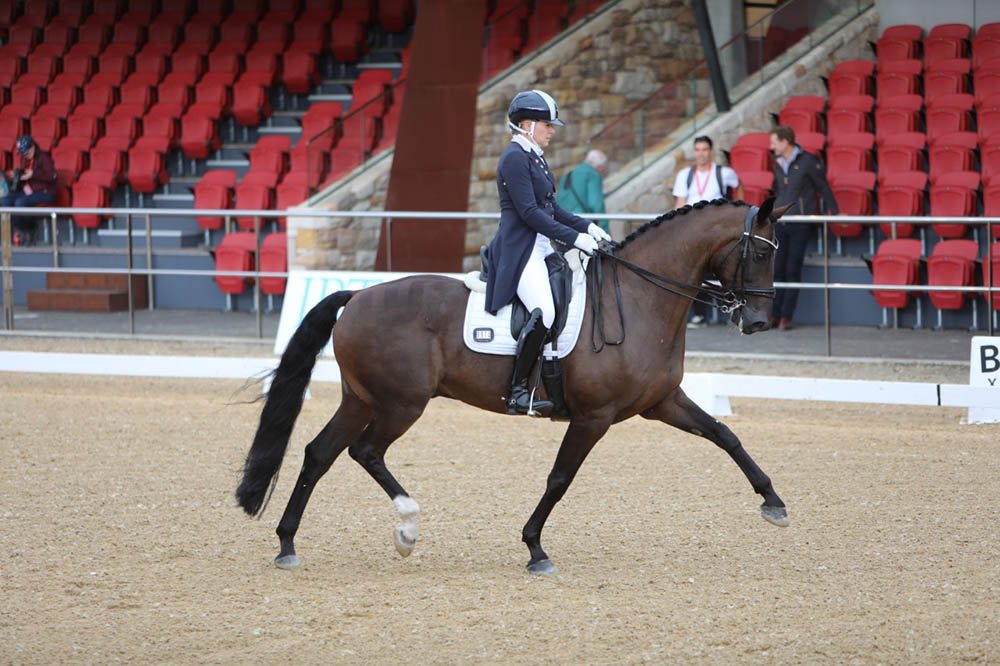
“I think they are very difficult tests,” says Grand Prix rider, coach and former FEI judge, Roger Fitzhardinge. “A lot of riders do go straight to Inter II, however, the Inter A and B tests are interesting and certainly have very good value for training and schooling.”
So, if you’re using the Medium Tour tests to bridge the gap between Small Tour and Grand Prix, how do you make sure you’re achieving the best possible marks in these tests?
1. Adjustability is crucial.
“At the Inter A and B level, it is really an extension of all the exercises that have been done up until now with huge accent on transitions and adjustability. So, ‘adjustability’ is one of the biggest words needed in these tests,” begins Roger. “The adjustability isn’t only in the footfalls and the steps, but also in the lengthening and shortening of the frame, and in the lateral submission in steps left and right, and that ability to be able to change flexion.
“This is what this test really looks for, this adjustability, and the clarity from one thing to another: piaffe to passage, piaffe to trot, half-pass zigzag canter to extended and then collected, canter to pirouette… it’s all about control and adjustability.”
Roger explains that the Inter A and B are very complicated tests and there are short periods in which to do things. For example, in the Inter A, the last bit sees horse and rider turn down the centreline in collected canter (following the one-tempis, mind you!) then transition to collected trot at D, passage at L, collected trot at I, and halt at G.
“You don’t want to prepare forever; you have got to be really on the ball and make the transitions quickly,” says Roger. Adjustability!
2. Fitness becomes even more important!
Roger explains that both Medium Tour tests are quite long and tiring — in particular the Inter B — and therefore both horse and rider need to be very fit. Despite being a movement shorter than the Inter A, the Inter B goes for approximately another 35 seconds. “The trotwork spans 14 movements (in the Inter B) and it goes forever,” notes Roger.
“It’s like a marathon, the Inter B… you’ve gotta be ready to run in the Melbourne Cup to do this test. When you ride it, you will realise how long it goes for. Be warned, your horse needs to be very, very fit — and so do you!”

“Both horse and rider
need to be very fit.”
3. Know your horse’s stride length and ride for symmetry and straightness in the tempi changes.
The Inter A and B both have one and two-tempi changes, each with seven flying changes of leg — the exception being the one-tempis in the Inter B, which requires nine changes. This serves as an intermediary for the Grand Prix, where 15 one-tempi changes are required.
“Probably for me I think the one-tempi changes are one of the hardest exercises,” begins Roger. “Make certain that you know your horse’s stride length and that you can make an equal number of strides before and after the tempi changes; symmetry is good. The third change should be really over X.” Roger points out that in the Inter B, the diagonal for the two-tempis is R-K, which is shorter. “Be careful… you will need to start a little earlier!”
So what else does the rider need to be mindful of? “The judges will be looking for straightness and not swinging. For the ones in particular, make certain that you put your horse very well in a collected and active and almost hot-feeling canter, which allows you to keep the horse going into the bridle and upwards and forwards in those changes.”
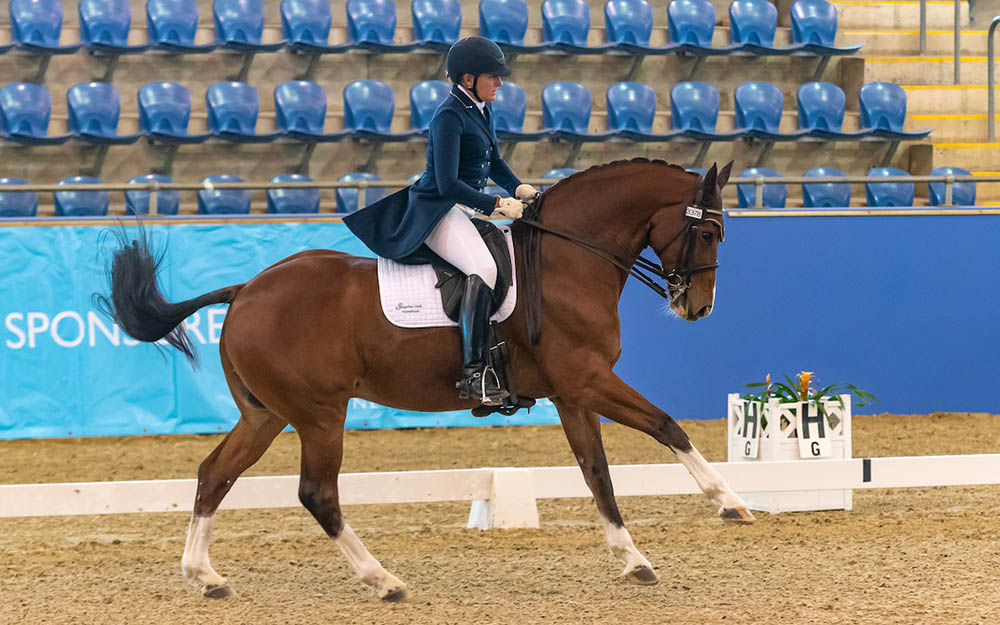
“You’ve gotta be ready to run in the
Melbourne Cup to do this test.”
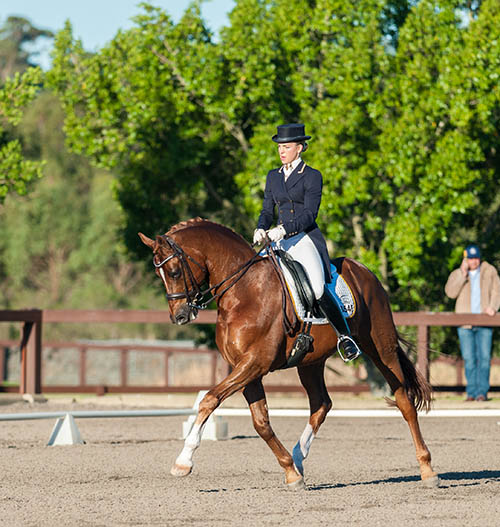
4. Symmetry is also important in the half-pass movements.
In the Inter A, the half-passes in trot are, like in the Inter II, five metres either side of the centreline. “So you start on the centreline and go to the quarterline, and then back across it to the other quarterline and back to the centreline,” explains Roger. “Symmetry from quarterline to quarterline is important. As far as positioning goes, you should cross the centreline at X. It is very important to have that symmetry; that is, the equality sideways movement and the equality of the flexion left and right. If, for example, you can flex a lot to the left and not so much to the right, it is much better to not show that exaggerated difference in the flexibility.
“The change of bend and flexion from one direction to the other is important, and as you get to the quarterline the horse should literally be straight, go shoulder-fore position, and then away in the new direction in the half-pass.”
The trot half-pass in the Inter B is interesting, as it can be started between F and P to S (and M and R to V). “You can make it longer or shorter, it’s up to you. I would rather see a longer (less steep) one done really well than a shorter (steeper) one with irregular steps. So, I would start early if I was riding it, and make it fluent.”
In the Inter B, there is then the tricky movement down the centreline with four canter half-passes of four strides left, eight strides right, eight strides left, and four strides right. “You have got to learn to count and you make certain that you count the first half-pass step as ‘1’ – don’t go across in six or seven strides in the first half-pass. You’ve got to count ‘4’ and make your change on the fourth,” says Roger.
“Don’t go too sideways, because you will never ever get back to the other side in the eight strides. Again, be symmetrical, and don’t exaggerate the flexion and bend, otherwise you will find that you will lose the quarters and any short side-positioned judges will see this. Don’t exaggerate the positioning; make certain you can achieve 4-8-8-4 to begin with, then increase the suppleness and then increase the degree of angle that you ride over time. Be consistent throughout.”
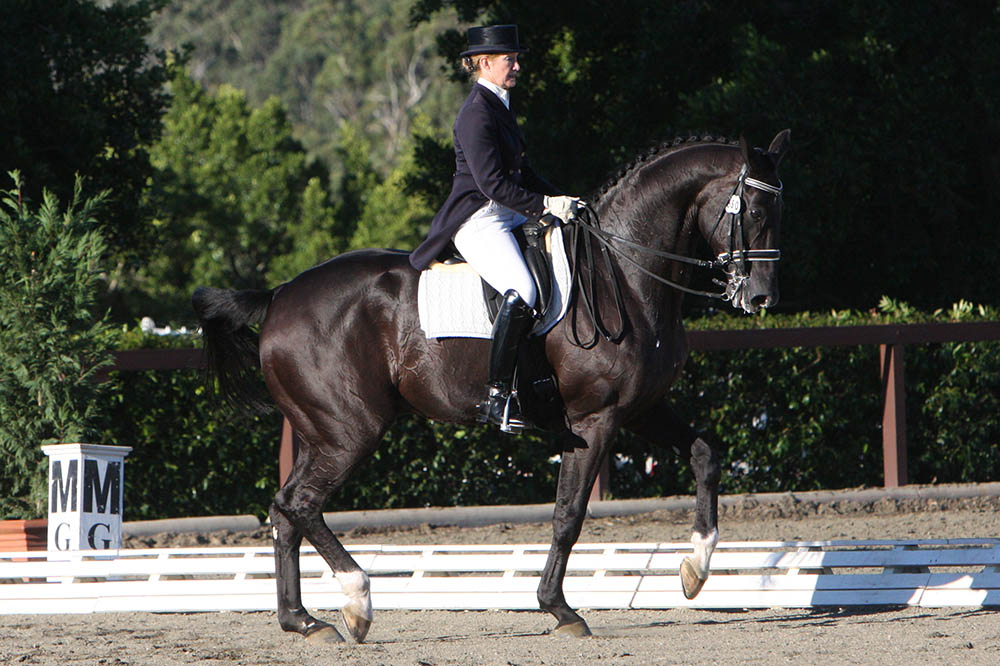
“I think the one-tempi changes are
one of the hardest exercises.”
5. It’s finally time to piaffe… and don’t forget to breathe!
The Medium Tour tests see the introduction of the piaffe; in the Inter A and B tests, you are required to show 7-10 steps of piaffe, compared to the Grand Prix that asks for 12-15 steps. These tests allow for half steps moving two metres forward, so it doesn’t have to be on the spot as in the Grand Prix.
Roger explains that in riding the piaffe, the steps should engage the hind legs lower and the forehand should be higher — and preparation for this begins in the passage. “If the passage gets too slow and too open and not elastic and forward enough, it’s going to be difficult to engage the hind legs for the piaffe.”
Roger also notes that with the allowed two metres of forward movement, aim to make the execution of the piaffe symmetrical. “It is important to make certain that in going two metres forward you start the piaffe a metre before C and finish a metre after C, so it’s all symmetrical, controlled and adjustable. Keep the piaffe steps active and regular, and don’t block the forward movement.”
In addition to marks for the passage and piaffe, there is also a mark purely for the transitions from passage to piaffe to collected trot (Inter A) and passage to piaffe to passage (Inter B). “For me, I think you need to breathe at the end of the piaffe,” says Roger, in regards to riding a smooth transition out of it. “For example, going from piaffe to trot, it’s hands quietly forward-thinking, lower leg near the girth — with the piaffe your lower leg is a little back — so bring the leg forward and think forward into a very positive trot. It is not easy sometimes to get out of the piaffe, but it is the same rhythm: two-beat, forward and back.”
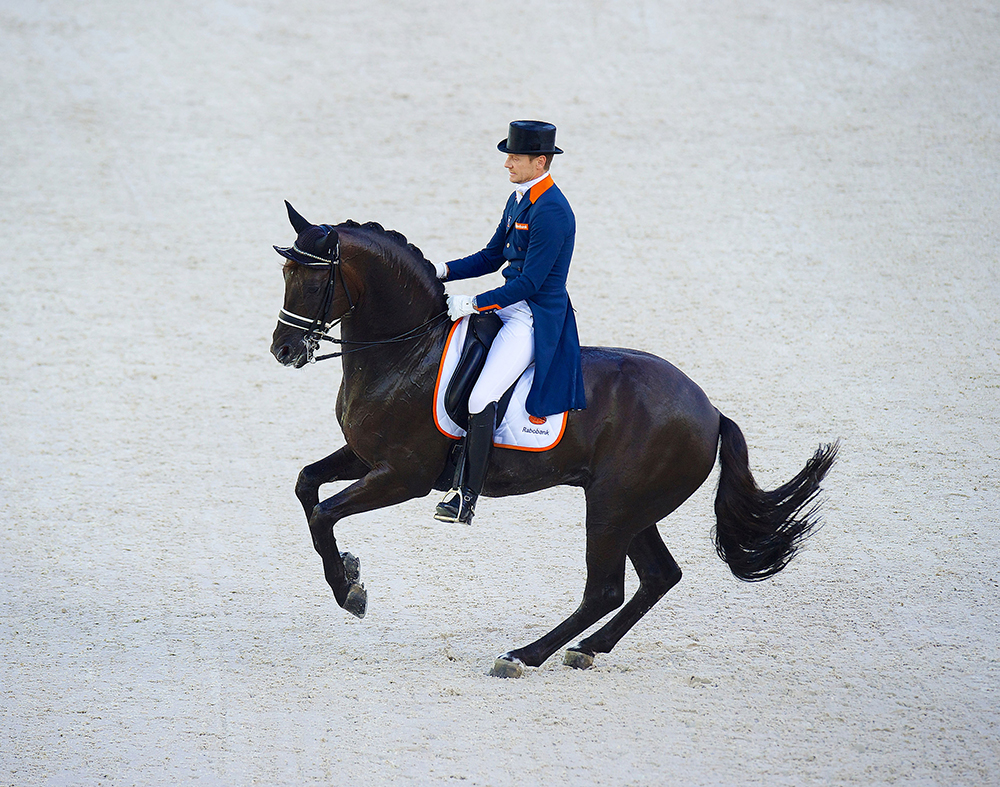
“You need to breathe at the end
of the piaffe.”
6. Preparation is key for the pirouettes — and make sure there is a clear difference between your collected and pirouette canters.
“Then when you think you’ve finished the test – because you’re exhausted – there are the canter pirouettes!” says Roger. In the Inter B in particular, they are the last movement before the final centreline. As Roger explains, the pirouettes are coefficient marks and are therefore worth 20 marks each.
Roger notes that accuracy is very important. In both tests you turn across a short diagonal and make a full pirouette in canter halfway across (at L or I). “In the Inter A leading into the pirouettes, I would make the flying change a little earlier (it can be made between P and B, and V and E) so you’re balanced to the corner and can show adjustability that you can do the flying changes.”
Roger also points out that you shouldn’t collect and shorten for the pirouette too soon. “After the flying change (in the Inter A) it’s straight on the long side, then the turn to the short diagonal and then collection. You only need to collect approximately three steps before I. Don’t start collecting as soon as you turn on the diagonal because you will run out of energy and impulsion.”
As Roger stressed in his article on riding the Prix St Georges test, one of the key things with canter pirouettes is ensuring you make a clear difference between the pirouette canter and the collected canter — too often, they can look the same! “So you must go pirouette canter, collected canter, flying change, collected canter, pirouette-canter. So there’s a clear difference.
“Make certain that when you come out of the pirouette you ride forward into collected canter again. The pirouette canter is not a collected canter; it is an ultra-collected canter cantering on the spot. So when you’ve finished the pirouette, adjustability shows that you can ride forward and make the flying changes afterwards. So you have got to have that adjustability to get the good marks in the flying change.”
7. The passage is worth a lot of marks and the transitions in and out of passage are important.
Just like the piaffe, passage appears for the first time in the Medium Tour tests. In the Inter A, it’s first introduced after a half 20m circle in collected trot. “So you go on a half-circle for 20 metres, and between the centreline and the long side, transition to passage. Even though it sounds like you can develop the transition to passage, it is best if it is seen very clearly. You need to collect the trot a lot with energy and engagement with a raised forehand, nose approaching the vertical, and then a clear transition within one or two steps into the passage.” Clarity of the transition and the regularity of the passage are important, as there are separate marks for both.
The final centreline, as mentioned in the first point on adjustability, sees the horse go from collected trot, to passage and then back to collected trot before the halt. “You have to have a very good, energetic collected trot, very in front of your leg – so that you can then collect within one or two steps and make a clear transition at L to passage; passage all the way from L to I, and then at I you breathe out, relax and transition to collected trot again, so there’s a clear difference.”
Roger notes that in the Inter B, the passage accounts for a lot of marks. “There is a transition between S and H to passage, which gains a mark, and a mark for the passage, and then the piaffe, and then forwards into passage and there’s a transition mark again for passage-piaffe-passage. So here you get 10 marks for the initial transition to passage, 10 marks for the passage, 10 marks for the passage-piaffe-passage transition, and 10 marks for the following passage. So in those few movements you get 40 marks relating to the passage. You must be able to go passage-piaffe-passage and make those transitions clear and regular.” There is then a further 30 marks for the passage and transitions in and out on the other rein, for a whopping total of 70 passage-related marks in this test.
8. Work the walk
In both tests — and it’s the same when you get to Grand Prix — the extended walk and collected walk are both allocated coefficient marks, and to make the most of these you need to ride very clear transitions between the two.
“The extended walk requires plenty of length of rein but still contact, not looping reins; it’s not loose rein, it’s on the bit, it’s nose forward and opening the gullet, with the biggest steps possible,” says Roger. In both tests, the extended walk then transitions to collected walk. “There needs to be a very clear transition to collected walk. Now, this must show an adjustable frame… long frame, short frame, poll the highest point, and engagement.
“The collected walk should feel like you can do piaffe from it; I have said it all along for all the other levels, and now you get the chance (in the Inter A). On approaching A in the collected walk (movement 11) you piaffe 7-10 steps. The collected walk has to be very short and very collected, and feeling hot and excited… almost like you’re about to break into a jog but you keep the collection shorter and shorter and shorter and then the piaffe steps at A.”
Another little tip that Roger has, following the piaffe at A in the Inter A test, is to ensure the horse is in front of your leg in the collected trot afterwards. “Be careful, if they’re not in front of your leg as you go around that corner after the piaffe in collected trot, I can guarantee they are going to canter when you cross the diagonal and ask for extended trot.”
9. Don’t over practice the rein-back to canter
The Inter B includes a rein-back, which follows a halt at G and then requires the horse to proceed in collected canter. As Roger explains, you don’t need to practise that movement too often. “The horse can learn to anticipate it a lot — so don’t practise it at G.
“It is not a particularly hard movement; the four steps are counted from the front legs, i.e. four footfalls from the front. You’ve got to have the horse feeling that he’s always forward in front of your leg and ready to spring forward after any step. You want to make certain that you rein-back and then ride directly from rein-back to canter, and make certain you go straight ahead from G to M and then ride a corner – it shouldn’t be on a curving line like a quarter 20m circle.”

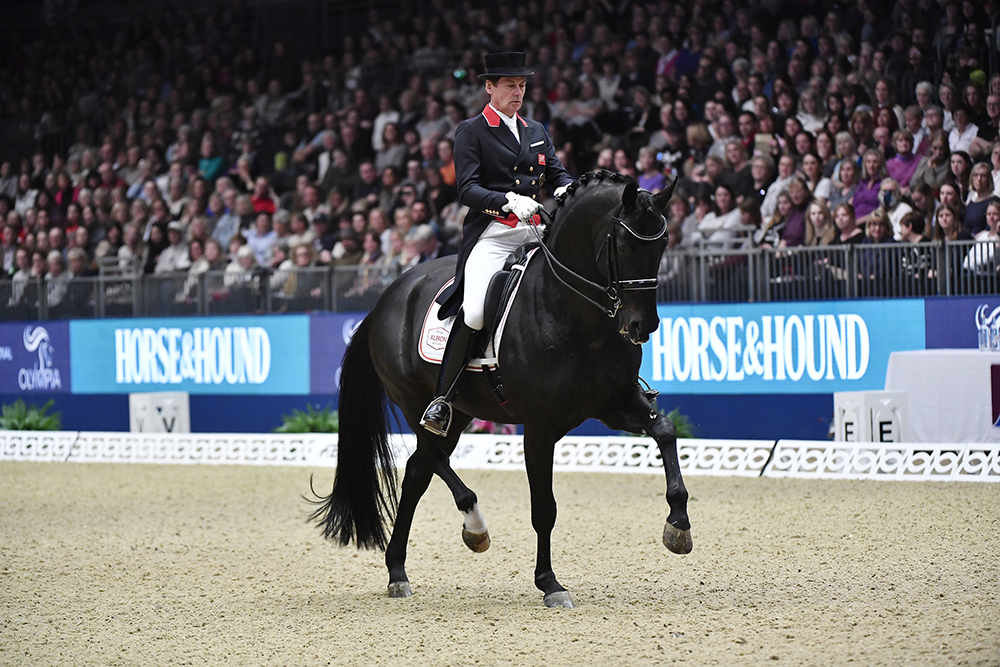
10. Make sure your horse stays still in the halt — and give him a pat!
“Of course, it’s straightness and rider attitude at the end of the test!” says Roger. “Make sure that you reward your horse, make certain that it stands dead motionless, and when you salute it stays still until you pick up the reins from the salute, and let the reins go long in preparation to leave the arena. Make certain he stays there and then walk forward. The number of marks that get lost by horses moving before the rider asks is incredible and it is enough to make the difference between first and second! So pay attention to those halts.”
View the Medium Tour tests here:
Riding the Preliminary, Novice, Elementary, Medium, Advanced or Prix St Georges tests? Roger has covered these in our previous issues:
10 Tips for Riding the Preliminary Tests
10 Tips for Riding the Novice Tests
10 Tips for Riding the Elementary Tests
10 Tips for Riding the Medium Tests
10 Tips for Riding the Advanced Tests
10 Tips for Riding the Prix St Georges Tests
EQ

